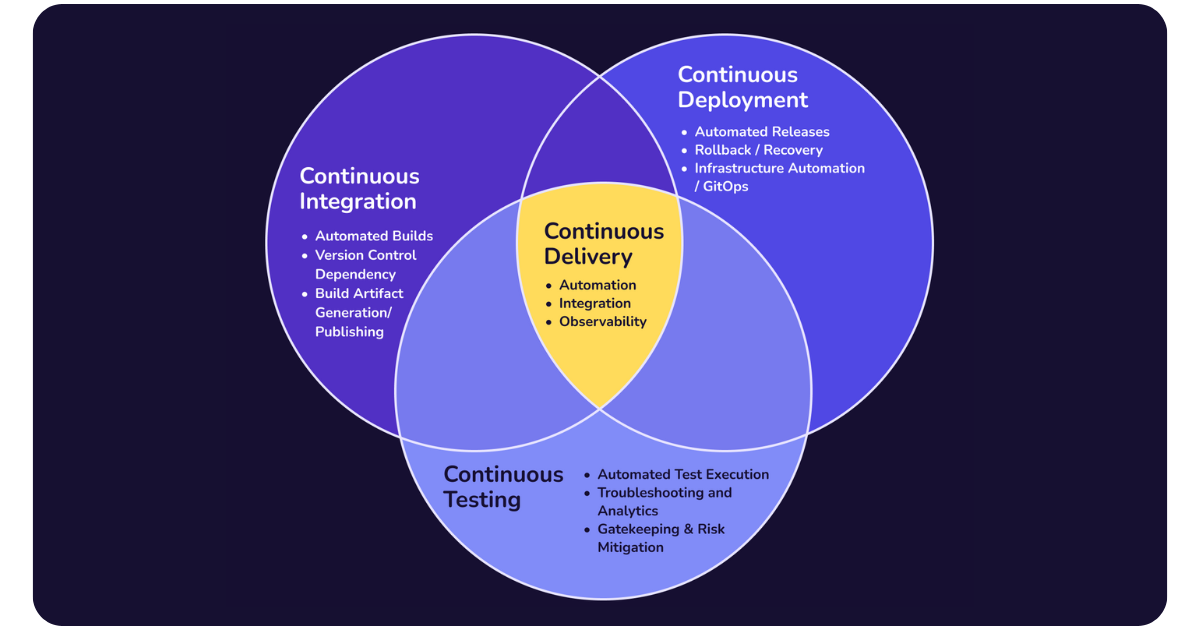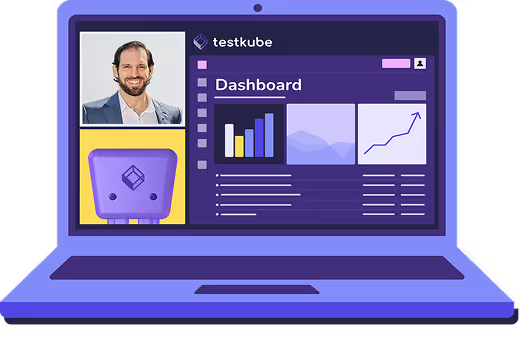Table of Contents
Try Testkube instantly in our sandbox. No setup needed.
Try Testkube instantly in our sandbox. No setup needed.




Table of Contents
Executive Summary
You’re Doing It!
Many teams are doing test orchestration today. You may not call it that, but if you're managing hundreds or thousands of automated tests across services, environments, and pipelines, then congratulations: you're in the test orchestration business.
You might be, for example:
- Storing tests in Git, triggering them with Jenkins jobs or GitHub Actions.
- Running all smoke tests after each commit, all integration tests on every merge, and End-to-End tests before deployment.
- Managing infrastructure for test environments with scripts.
- Triggering tests on deployment with ArgoCD or Flux.
- Writing custom scripts to parse test results and send Slack alerts.
Home-grown, sometimes duct taped, it works until it doesn't. And the more tests you have, the more error prone and maintenance heavy it becomes. When each team scripts their own test flows, results live in 10 different dashboards, and only a few DevOps engineers know how it all connects... it breaks. It doesn't scale. It's not transparent. It's not sustainable.
Most development teams lack a strategic approach to testing orchestration, treating it as an afterthought rather than a core development practice. This creates a counterproductive cycle: as testing requirements increase, the process becomes increasingly inefficient. The result is delayed product releases, defects that slip into production, and wasted development resources that could have been allocated more effectively.
What Test Orchestration Actually Means
Test orchestration is the practice of managing how, when, and where tests are executed, across systems, tools, teams, and environments. Think of it as the connective tissue between your tests, your infrastructure, and your developers.
Where test automation is about creating individual tests that automatically test your applications and services (using Playwright, Postman, Cypress, JMeter, K6, custom scripts), test orchestration is about making sure those tests are used effectively and efficiently. That is easier said than done.
Here's what that looks like in practice:
1. Test Execution - Creation and Triggering
- Running the right tests for the right component at the right time.
- Triggering tests on demand, on schedule, or on events (like a Git commit, deployment, or cluster change).
- Coordinating tests across microservices, APIs, UI layers, infrastructure, and even security scanners.
- Combining multiple tests to run in sequence or parallel to ensure your application can handle real-life usage consistently and securely.
- Running the same test with different input parameters depending on where/how/why you run them.
2. Execute, Optimize, Debug
- Parallelizing and sharding test workloads to optimize resource consumption and execution times
- Targeting tests by service ownership, environment, or recent code changes.
- Re-running only the relevant failures related to recent code or infrastructure changes instead of the full suite.
- Suppressing (or fixing) noisy or flaky tests, so you can focus on what matters.
3. Results Collection, Analysis, and Test Observability
- Centralizing logs, artifacts, videos, traces, and test metadata from multiple tools and your system under test into a single, searchable system for efficient and secure troubleshooting
- Making it easy to debug test failures, compare runs, and drill down into failure patterns.
4. Reporting & Metrics
Answering key questions like:
- What’s our average test duration by environment?
- Who owns the flakiest test suite?
- How is the quality of our key application components changing over time?
- How much are we spending on tests in our CI/CD pipelines?
What About Continuous Testing?
Continuous Testing is an established paradigm analogous to Continuous Integration (CI) and Continuous Deployment (CD). While CI focuses on optimizing the assembly of deployable artifacts and CD focuses on deploying those artifacts across environments and infrastructure, Continuous Testing (CT) focuses on ensuring automated tests are executed across both these practices and beyond, solving challenges related to test scalability and test observability that are not covered by CI/CD tooling.

In cloud-native application delivery, efficient Test Orchestration is a prerequisite for implementing a successful Continuous Testing regime.
Here’s why:
- Microservices everywhere. Dozens of independently deployed services. Tests need to be aware of interactions, dependencies, and contracts across systems.
- More environments. You’ve got Dev clusters, staging, ephemeral review apps, production mirrors, blue/green deploys and each has different constraints and test needs.
- Dynamic infrastructure. Kubernetes, serverless, edge workloads, autoscaling. You need to test not just the code, but how it behaves in this fluid context.
- AI-generated code. It’s easier than ever to create code and, increasingly, test code too. But more doesn’t always mean better. Who ensures it all runs, at the right time, for the right reason?
- Speed of delivery. Product teams want to ship every day. Testing can’t become a bottleneck, and you can’t solve the problem by hiring more QA folks or platform engineers.
When to Invest in a Test Orchestration Platform
So how do you know it's time to move beyond ad hoc solutions? Here are some common inflection points that signal the need for a dedicated test orchestration layer:
- Wasted Dev cycles - There are hundreds of test suites, and your CI/CD scripts require time from DevOps or Platform Engineers, creating and maintaining infrastructure specific to test automation. How much time is too much? - More than a few minutes per week.
- Developer Productivity - An organization would like to enable Engineers to run tests earlier in the development cycle, empowering teams to use the best testing tools that fit their needs yet having a central place to share Test Results, Artifacts, and Reports. Additionally, debugging test failures becomes a team sport. Engineers waste hours jumping between tools - hunting for logs, deciphering flaky test patterns, or trying to reproduce issues locally.
- Developer Experience - There is a need to leverage automated tests across teams, run specific test suites consistently across teams, clusters, environments.
- Improve Quality - Production deployments are a special event necessitating war rooms, on-call emergency support, and a dedicated cross functional team effort.
- Scaling - You're scaling teams or services. More teams, more services, more environments - without a shared test execution strategy, chaos grows linearly (or worse).
- Cost - Test costs are rising with no visibility. You're running a lot of tests, but don't know which ones are useful, which are wasteful, or what they cost to run.
- Governance - Compliance requirements demand test traceability. Regulated industries need to show which tests ran when, with what results, and by whom for audit purposes.
The Test Orchestration Mandate
If you're scaling software delivery, you should consider scaling test orchestration. That means investing in a purpose-built test orchestration layer that sits alongside your CI/CD, not buried inside it. One that can:
- Decouple test logic from CI pipelines, so tests aren’t tied to Jenkins scripts or YAML sprawl.
- Run heterogeneous tests (UI, API, load, compliance, etc.) - regardless of vendor or framework - in consistent and resilient environments.
- Coordinate executions across clusters, teams, Geo’s, and clouds.
- Provide insights and test observability as a first-class citizen.
- Empower platform and DevEx teams to build reusable workflows that scale across teams within your org
What to Watch Out For
Key challenges and recommendations for implementing test orchestration:
Bottom line
For teams feeling the strain of scale, the payoff is clear. Better software delivered faster with more confidence, less friction, and a foundation for sustainable Continuous Testing culture. The key is thoughtful, incremental adoption rather than trying to solve everything at once.
Own Your Continuous Test Orchestration Strategy
You’re likely orchestrating tests. The question is, are you doing it intentionally, observably, and scalably? Are you doing it in a way that empowers Continuous Testing across your SDLC?
The longer you delay investing in a dedicated test orchestration layer, the more brittle and complex your pipelines will become, and the harder it’ll be to deliver software faster, with the high level of quality, and without increased infrastructure costs.
If you want to keep up with the speed of modern development, it’s time to stop treating test orchestration as a side-effect of CI/CD and start treating it as a first-class part of your engineering platform.


About Testkube
Testkube is a cloud-native continuous testing platform for Kubernetes. It runs tests directly in your clusters, works with any CI/CD system, and supports every testing tool your team uses. By removing CI/CD bottlenecks, Testkube helps teams ship faster with confidence.
Explore the sandbox to see Testkube in action.



